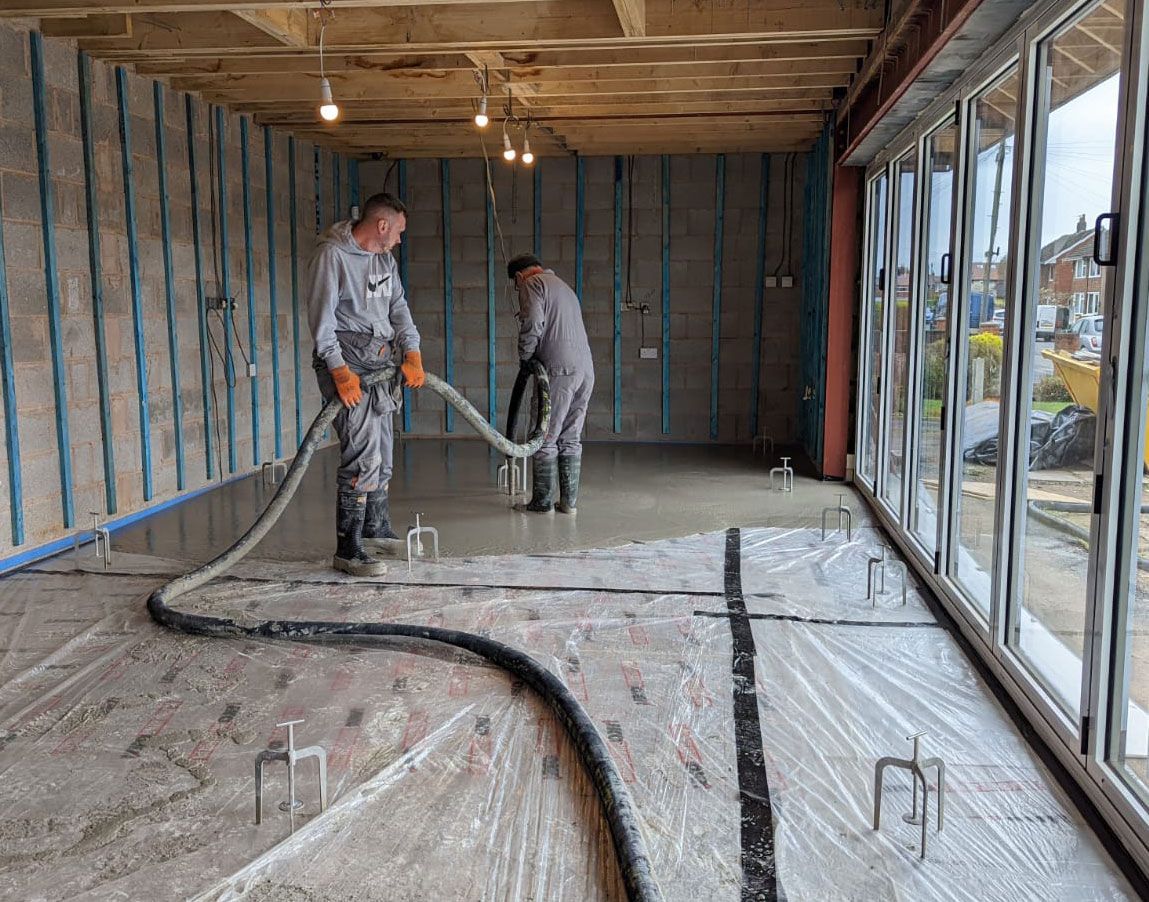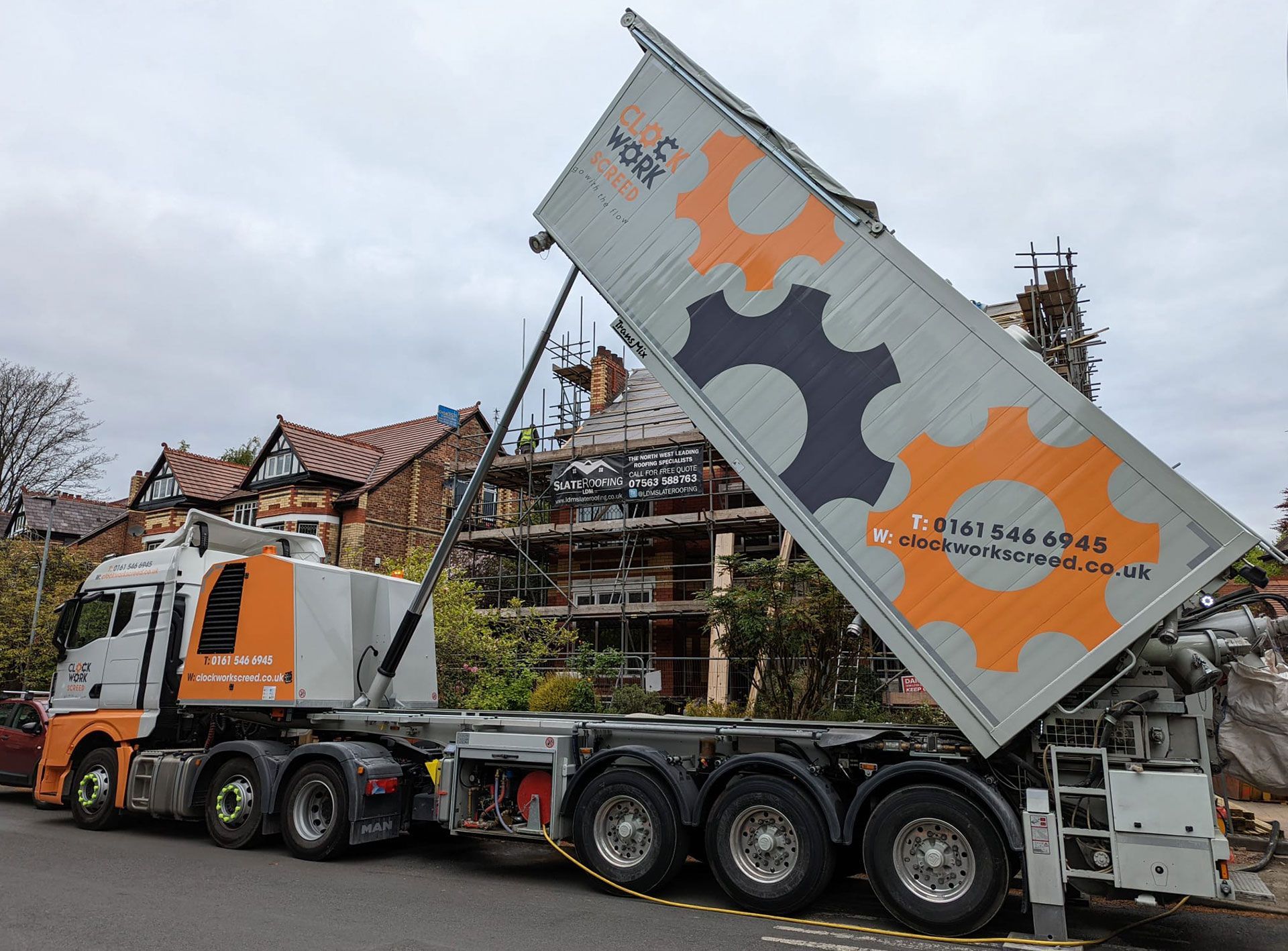 Add My Company
Add My Company

LIQUID SCREED: A FOUNDATION FOR FLOORING
Screed is a thin layer of material applied to a subfloor to create a smooth, level surface for the final floor covering, such as tile, carpet, or hardwood. It ensures a uniform base for the flooring material to be installed upon, eliminating any unevenness that could affect performance or aesthetics.
There are two main types of screed commonly used:
- Traditional Sand & Cement Screed: This is a time-tested method that mixes sand, cement, and water to create a mortar-like material. It's relatively inexpensive but requires a longer drying time (up to several weeks) and can be prone to cracking if not mixed and applied properly.
- Liquid Screed: This is a more modern approach that utilises a pre-mixed, self-levelling compound often containing calcium sulphate. It offers a clean and tidy installation process and a faster drying time (typically 24-48 hours).
Liquid screed offers several advantages over traditional sand & cement screed, making it a compelling choice for many projects.
Get a Liquid Screed Quote Today!
TRADITIONAL SAND & CEMENT SCREED: A TIME-TESTED FOUNDATION

Traditional sand & cement screed has been a workhorse in construction for centuries. This reliable method creates a strong, level base for various floor finishes. Made with a simple mixture of:
- Sand: Provides the bulk and structure to the screed. The specific size and type of sand chosen will impact factors like drying time and strength.
- Cement: Acts as the binding agent, holding the sand particles together and hardening over time to create a solid surface.
- Water: Activates the cement, allowing it to chemically react and bind the sand particles together. The precise amount of water is crucial for achieving the right consistency and avoiding cracking.
This simple recipe, when mixed and applied correctly, offers several advantages:
- Durability: Traditional screed, once cured, is incredibly strong and long-lasting. It can withstand heavy foot traffic and other demands placed upon it.
- Affordability: The readily available materials make sand & cement screed a cost-effective choice for many projects, particularly for larger areas.
However, it's important to consider that traditional screed also comes with some drawbacks, paving the way for the emergence of newer options like liquid screed.
LIQUID SCREED: A MODERN APPROACH TO FLOOR LEVELLING
Liquid screed, also known as self-levelling screed, is a modern alternative to traditional sand & cement screed. It offers a quicker and more efficient way to achieve a smooth, level floor base.
The primary component of liquid screed is:
- Calcium Sulphate: This mineral binder, often in the form of anhydrite, reacts with water to form a gypsum-based compound. Unlike cement, it doesn't require a high-alkaline environment to cure, making it less susceptible to certain types of cracking.
The application process of liquid screed is significantly different from traditional screed:
- Pumped: The pre-mixed liquid screed arrives ready-to-use and is pumped directly onto the prepared subfloor. This eliminates the need for on-site mixing and manual labour, saving time and effort.
- Self-Levelling: Due to its specially formulated composition, liquid screed flows freely and naturally levels itself across the surface. This minimises the need for manual smoothing, ensuring a consistently flat finish.
This combination of pre-mixed materials and self-levelling properties makes liquid screed a faster and less labour-intensive solution compared to traditional sand & cement screed.
TOP REASONS TO CHOOSE LIQUID SCREED

1. THE ADVANTAGES OF A THINNER, FASTER CURE: WHY LIQUID SCREED SHINES
One of the most significant advantages of liquid screed lies in its ability to be laid thinner than traditional sand & cement screed. This is due to a few key factors:
- Self-levelling properties: Liquid screed's ability to flow and find its own level eliminates the need for a thick layer to achieve a flat surface. Traditional screed requires a thicker application to account for manual troweling and potential unevenness.
- Reduced shrinkage: The composition of liquid screed minimises shrinkage as it cures, allowing for a thinner application without compromising structural integrity. Traditional sand & cement screed can experience more shrinkage during drying, necessitating a thicker base layer.
The ability to be laid thinner translates to another major benefit: a faster cure time. Liquid screed typically cures within 24-48 hours, compared to several weeks for traditional screed. This rapid curing time offers several advantages:
- Reduced project downtime: With a quicker drying time, projects can progress much faster with liquid screed. This minimises the time a floor remains unusable, allowing for earlier installation of the final flooring and completion of the project.
- Earlier occupancy: In applications like renovations or new builds, a faster cure time for the screed translates to earlier occupancy of the space. This can be crucial for businesses looking to minimise downtime or homeowners eager to move in.
2. SUPERIOR PERFORMANCE WITH UNDERFLOOR HEATING
Beyond its time-saving advantages, liquid screed offers a significant benefit for projects involving radiant heating systems: superior heat transfer due to its ability to better fill gaps around pipes.
Traditional sand & cement screed, due to its manual application process, can struggle to completely fill in the spaces around embedded pipes. These air pockets can act as thermal insulators, hindering the efficient transfer of heat from the pipes to the floor surface. This inefficiency translates to:
- Higher energy consumption: To achieve the desired heating effect, the system may need to work harder, consuming more energy to overcome the insulating effect of air pockets.
Liquid screed, with its inherent self-levelling properties, excels at filling these gaps around pipes. The fluid nature of the material ensures it flows and conforms to the contours of the pipes, minimising air pockets and creating a more uniform thermal mass. This translates to several advantages:
- Optimal heat transfer: With minimal air gaps to impede heat flow, liquid screed allows for a more efficient transfer of heat from the pipes to the floor surface. This minimises wasted energy and ensures a more comfortable and consistent heating experience.
- Potential energy savings: The improved heat transfer efficiency associated with liquid screed can lead to lower energy consumption for the heating system. This translates to cost savings on energy bills over time.
We work with our sister company, Clockwork Underfloor Heating, in installing underfloor heating systems to buildings in Stockport, Cheshire and Manchester.
3. REDUCED CRACKING & SHRINKAGE
One of the inherent challenges with traditional sand & cement screed is its susceptibility to shrinkage and cracking as it dries. This can occur due to several factors, including the amount of water used in the mix and uneven drying conditions. These cracks can compromise the integrity of the floor and may require repairs before installing the final flooring material.
Liquid screed offers a significant advantage in this regard thanks to its unique composition:
- Reduced Shrinkage Potential: The primary binder in liquid screed, calcium sulphate, undergoes a different chemical reaction compared to cement. This reaction results in less shrinkage during the curing process. Additionally, the pre-mixed nature of liquid screed ensures a consistent water content, further minimising the risk of shrinkage-induced cracks.
- Minimised Cracking: By reducing shrinkage, liquid screed inherently minimises the stress placed on the material as it cures. This translates to a lower likelihood of cracking compared to traditional screed.
The minimised risk of shrinkage and cracking associated with liquid screed offers a practical benefit:
- Smoother, More Level Finished Surface: Because liquid screed cures with less shrinkage and cracking, the finished surface is inherently smoother and more level. This reduces the need for additional smoothing or levelling steps before installing the final floor covering, saving time and labour.
4. THINNER PROFILE & WEIGHT
One of the key advantages of liquid screed is the ability to be laid significantly thinner than traditional sand & cement screed. Beyond the time-saving benefits discussed earlier, a thinner layer of liquid screed offers additional advantages:
- Reduced Floor Load: The inherent weight of traditional sand & cement screed can contribute to a significant load on the floor structure. By utilising a thinner layer, liquid screed reduces the overall weight placed on the floor, particularly relevant in multi-story buildings.
- Potential for Use in Upper Floors: In some cases, building codes or structural limitations may restrict the use of traditional screed on upper floors due to its weight. The reduced floor load associated with a thinner liquid screed application can make it a viable option for these situations.
LIQUID SCREED WITH CLOCKWORK SCREED
Liquid screed offers a compelling alternative to traditional sand & cement screed, boasting several key advantages. Its self-levelling properties and faster cure time translate to quicker project completion and earlier occupancy. The thinner application reduces weight on the floor structure, making it suitable for upper floors or renovations with weight limitations. Additionally, liquid screed's composition minimises shrinkage and cracking, leading to a smoother finished surface.

However, traditional sand & cement screed remains a trusted and cost-effective option for many projects. To determine the best screed type for your specific needs, consulting a professional is highly recommended. They can assess your project requirements and recommend the most suitable solution based on factors like budget, timeline, and floor structure.
For more information on LIQUID SCREED V TRADITIONAL SAND AND CEMENT, 5 REASONS TO CHOOSE LIQUID SCREED talk to Clockwork Screed Ltd
